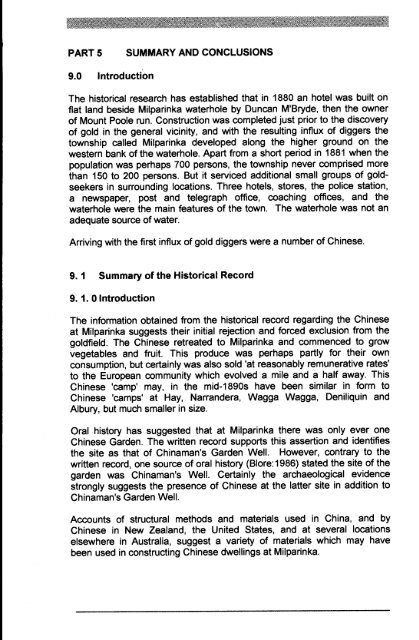Adec Preview Generated PDF File - The Sydney eScholarship ...
Adec Preview Generated PDF File - The Sydney eScholarship ...
Adec Preview Generated PDF File - The Sydney eScholarship ...
You also want an ePaper? Increase the reach of your titles
YUMPU automatically turns print PDFs into web optimized ePapers that Google loves.
PARTS SUMMARY AND CONCLUSIONS<br />
9.0 Introduction<br />
<strong>The</strong> historical research has established that in 1880 an hotel was built on<br />
flat land beside Milparinka waterhole by Duncan M'Bryde, then the owner<br />
of Mount Poole run. Construction was completed just prior to the discovery<br />
of gold in the general vicinity, and with the resulting influx of diggers the<br />
township called Milparinka developed along the higher ground on the<br />
western bank of the waterhole. Apart from a short period in 1881 when the<br />
population was perhaps 700 persons, the township never comprised more<br />
than 150 to 200 persons. But it serviced additional small groups of goldseekers<br />
in surrounding locations. Three hotels, stores, the police station,<br />
a newspaper, post and telegraph office, coaching offices, and the<br />
waterhole were the main features of the town. <strong>The</strong> waterhole was not an<br />
adequate source of water.<br />
Arriving with the first influx of gold diggers were a number of Chinese.<br />
9. 1 Summary of the Historical Record<br />
9. 1. 0 Introduction<br />
<strong>The</strong> information obtained from the historical record regarding the Chinese<br />
at Milparinka suggests their initial rejection and forced exclusion from the<br />
goldfield. <strong>The</strong> Chinese retreated to Milparinka and commenced to grow<br />
vegetables and fruit. This produce was perhaps partly for their own<br />
consumption, but certainly was also sold 'at reasonably remunerative rates'<br />
to the European community which evolved a mile and a half away. This<br />
Chinese 'camp' may, in the mid-1890s have been similar in form to<br />
Chinese 'camps' at Hay, Narrandera, Wagga Wagga, Deniliquin and<br />
Albury, but much smaller in size.<br />
Oral history has suggested that at Milparinka there was only ever one<br />
Chinese Garden. <strong>The</strong> written record supports this assertion and identifies<br />
the site as that of Chinaman's Garden Well. However, contrary to the<br />
written record, one source of oral history (Blore: 1986) stated the site of the<br />
garden was Chinaman's Well. Certainly the archaeological evidence<br />
strongly suggests the presence of Chinese at the latter site in addition to<br />
Chinaman's Garden Well.<br />
Accounts of structural methods and materials used in China, and by<br />
Chinese in New Zealand, the United States, and at several locations<br />
elsewhere in Australia, suggest a variety of materials which may have<br />
been used in constructing Chinese dwellings at Milparinka.




